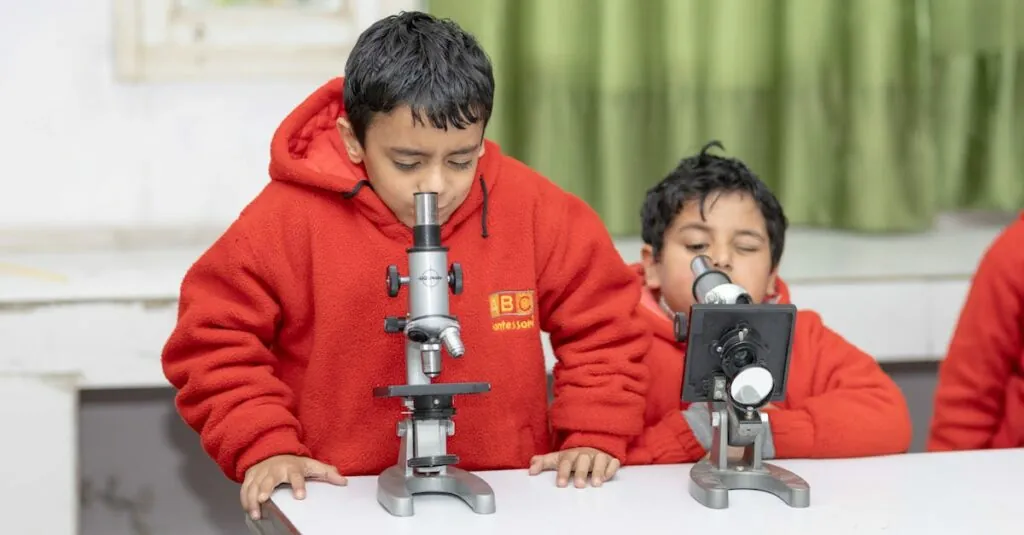Table of Contents
ToggleIn a world where kids are glued to screens, it’s time to shake things up with some exciting STEM challenges. Imagine your child trading video games for rocket launches and coding adventures. Sounds like a sci-fi dream? Not anymore! These challenges not only spark creativity but also turn learning into a thrilling quest for knowledge.
Understanding STEM Challenges For Kids
STEM challenges represent a critical opportunity for children. Engaging in activities that involve science, technology, engineering, and mathematics fosters creativity and problem-solving skills. Challenges can take various forms, including building structures, conducting experiments, and programming robots.
Hands-on experiences strengthen understanding and retention of STEM concepts. For instance, building a simple bridge using everyday materials like straws can introduce principles of engineering and physics. Through trial and error, kids learn the importance of teamwork and communication, which are vital for future collaboration in any field.
Incorporating STEM challenges into playtime enhances a child’s critical thinking abilities. A study by the National Science Foundation indicates that children exposed to engaging STEM activities perform better academically. Programs focus on real-world applications, making learning relevant and motivating.
Participating in competitions or group projects sparks enthusiasm. Kids often relish the chance to showcase their creations, whether designing a model rocket or coding a game. Encouragement from parents and educators boosts confidence and fosters a sense of achievement.
Adapting challenges for different age groups maximizes engagement. Solutions exist for preschoolers, such as simple coding toys, while older children might tackle robotics kits or data analysis projects. These tools cater to varying skill levels, ensuring all kids can participate successfully.
STEM challenges not only cultivate academic skills, but also prepare children for future careers. Half of all projected jobs in the next decade will require skills in STEM fields. By making these challenges accessible and enjoyable, society equips the next generation with essential skills for an evolving world.
Importance Of STEM Education
STEM education plays a vital role in shaping children’s future. Engaging in STEM challenges fosters enthusiasm for learning that translates beyond the classroom.
Benefits Of STEM Challenges
STEM challenges encourage hands-on learning experiences. Young participants boost critical thinking skills through experimentation. Observing their creations come to life inspires creativity and innovation. Academic performance improves, as studies show that kids involved in STEM activities achieve higher grades. Competitions spark teamwork, where collaboration becomes essential to success. Skills developed during these challenges promote persistence, resilience, and problem-solving abilities.
Skills Developed Through STEM Challenges
Participants in STEM challenges cultivate essential skills for future careers. Children enhance their analytical thinking by analyzing problems and finding solutions. Communication skills grow, as project collaboration requires sharing ideas and receiving feedback. Technical literacy becomes stronger through coding and robotics, preparing kids for a tech-driven world. Time management skills develop as they learn to prioritize tasks and meet deadlines. Overall, these activities equip children with a diverse skill set crucial for navigating an evolving job market.
Types Of STEM Challenges For Kids
Engaging in various types of STEM challenges allows kids to explore concepts through practical experiences. Two major categories stand out: hands-on activities and virtual challenges.
Hands-On Activities
Hands-on activities immerse children in the learning process. Building structures using materials like blocks or cardboard fosters creativity and problem-solving skills. Conducting simple experiments, such as creating vinegar and baking soda volcanoes, demonstrates scientific principles in an interactive way. Kids also enhance teamwork by working together on projects, reinforcing communication and collaboration skills. Activities like programming simple robots empower young learners to grasp technological concepts. Engaging in these challenges cultivates a deeper understanding of STEM subjects while making learning enjoyable and memorable.
Virtual Challenges
Virtual challenges offer a modern twist to STEM exploration. Online coding platforms introduce children to programming languages through interactive games. These platforms often provide guided tutorials that lead to building apps, websites, or games. Virtual simulations allow kids to experiment with physics concepts or chemical reactions without the need for physical materials. Engaging in competitions on virtual coding or robotics platforms nurtures a sense of community among participants. These challenges can often accommodate various skill levels, ensuring that all kids find opportunities to learn and excel, which promotes continuous growth in STEM knowledge.
Tips For Implementing STEM Challenges
Creating engaging STEM challenges requires a thoughtful approach that fosters creativity and collaboration among kids.
Creating A Problem-Solving Environment
Establishing a problem-solving environment encourages exploration and experimentation. Providing open-ended questions promotes critical thinking, allowing children to brainstorm multiple solutions. Setting clear objectives enables kids to understand the challenge while also giving them the freedom to innovate. Offering various materials invites creativity, as children can utilize everyday items in their projects. Creating a safe space for mistakes helps build resilience, ensuring children feel comfortable exploring new ideas. This culture of experimentation leads to deeper learning and reinforces the importance of trial and error in the scientific process.
Encouraging Team Collaboration
Fostering team collaboration enhances the overall learning experience in STEM challenges. Group activities promote communication, as kids share ideas and feedback. Assigning specific roles within teams encourages responsibility and accountability, allowing each child to contribute uniquely. Encouraging discussions about strategies helps develop negotiation and compromise skills, vital for success in future collaborations. Celebrating team achievements boosts morale, reinforcing the value of working together to solve problems. Moreover, creating friendly competitions incentivizes collaboration while also making the learning experience enjoyable, ultimately leading to more engaged participants.
STEM challenges offer children a unique way to engage with learning outside traditional methods. By participating in hands-on activities and virtual competitions, kids not only develop essential skills but also discover the joy of creativity and collaboration. These experiences lay the groundwork for future success in an increasingly technology-driven world.
Encouraging children to embrace STEM challenges fosters a lifelong love for learning, equipping them with the tools they need to thrive. As they tackle problems and innovate solutions, they build confidence and critical thinking abilities. Parents and educators play a vital role in nurturing this environment, ensuring that every child can explore and excel in STEM fields.








